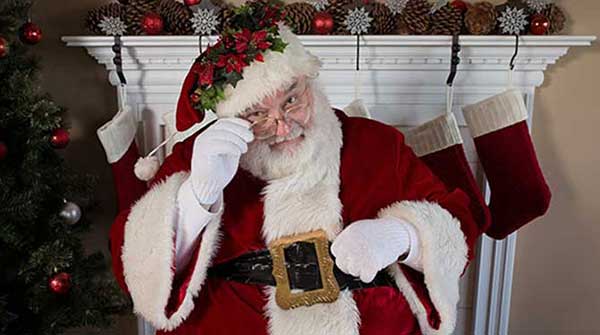Santa Claus is a first-class lie detector
 Have you ever wondered how Santa Claus determines whether to leave you a present or a lump of coal on Christmas? How he knows if you’ve been naughty or nice? I don’t have any hard evidence to back me up, but I’m pretty sure that he must be a first-class lie detector.
Have you ever wondered how Santa Claus determines whether to leave you a present or a lump of coal on Christmas? How he knows if you’ve been naughty or nice? I don’t have any hard evidence to back me up, but I’m pretty sure that he must be a first-class lie detector.
If so, here are some of Santa’s secrets:
He began with a baseline
The first and most important step in Santa’s deception detection was learning your baseline behaviour under relaxed or generally stress-free conditions. He could then compare it with the expressions, gestures, and other signals that are only apparent when you are under stress.
 |
| Related Stories |
| Are you lying or is your eye just itchy?
|
| Men are bigger liars than women
|
| Five tips to spotting liars at work
|
He watches you while you chat informally and notices how your body looks when you are relaxed. He sees your normal amount of eye contact and blink rate, the gestures you use most frequently, the posture you assume when you are comfortable, and your pace of speech and tone of voice.
Then, after he knows your behavioural baseline, he stays alert for meaningful deviations that signal a stress reaction (and possible deception) as you go through the days.
He notices when you’re faking
Seven basic emotions are shared, recognized, and expressed in the same way worldwide. Discovered and categorized by Paul Ekman and his colleagues at the University of California in San Francisco, the universal emotional expressions are joy, surprise, sadness, anger, fear, disgust, and contempt.
When you don’t genuinely feel the emotion you are trying to display, it often shows up in expressions that don’t use all the muscles in the face that are typically part of that emotion. For example, if your smile doesn’t include the eye muscles, it is not a felt smile. Real smiles crinkle the corners of your eyes and change your entire face. Fake smiles involve the mouth only and are often asymmetrical.
In monitoring your emotional reactions, Santa also looks for simulated emotions where you try to convince others that you felt a certain way by simulating the facial expression associated with that feeling. He notices your “terribly sincere furrowed brow” or your exaggerated display of anger that felt excessive. He knows, too, that any expression you display for more than five to 10 seconds is almost certainly being faked.
He keeps track of times when your verbal and nonverbal messages are not aligned
When your thoughts and words are in sync (when you believe what you are saying), it shows in your body language because your gestures, expressions, and postures align with your verbal message. But when Santa sees incongruence, where your nonverbal behaviour contradicts your words – such as a side-to-side headshake while saying “yes” or a slight shoulder shrug (which is a sign of uncertainty) as you state you are “absolutely positive” – he knows that verbal-nonverbal incongruence is often a sign of intentional deceit. At the very least, it shows an inner conflict of some sort between what you are thinking and what you are saying.
He looks for clusters
Clusters play a key role in Santa’s ability to spot lies. Your nonverbal cues occur in what is called a “gesture cluster” – a group of movements, postures and actions that reinforce a common point. A single gesture could have several meanings (or mean nothing at all), but the meaning becomes clearer when coupled with at least two other reinforcing nonverbal signals.
According to research by David DeSterno of Northeastern University (research that he has undoubtedly shared with Santa Claus), there is one specific cluster of nonverbal cues that proved statistically to be a highly accurate indicator of deception. The “telltale four” body language signals associated with lying are hand touching, face touching, crossing arms, and leaning away.
He judges you as being truthful or deceptive only after considering the following …
For the vast majority of us, the act of lying triggers a heightened (and observable) stress response. But here’s what complicates matters:
- Not all people demonstrate the same degree of emotion.
- Not all liars (especially if polished or pathological) display readily detectable signs of stress or guilt.
- Not all lies trigger a stress reaction. (Social lies, for example, are so much a part of daily life that they hardly ever distress the sender.)
- Truthful (“nice”) people can exhibit signs of anxiety for various perfectly innocent reasons, including the fear of not being believed or discomfort when speaking about embarrassing or emotional topics.
Santa Clause takes all this into consideration before visiting your house – and that’s why, on Christmas morning, you will receive all those wonderful gifts.
Carol Kinsey Goman, PhD, is an executive coach, consultant, and international keynote speaker at corporate, government, and association events. She is also the author of STAND OUT: How to Build Your Leadership Presence.
For interview requests, click here.
The opinions expressed by our columnists and contributors are theirs alone and do not inherently or expressly reflect the views of our publication.
© Troy Media
Troy Media is an editorial content provider to media outlets and its own hosted community news outlets across Canada.


